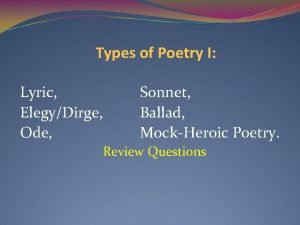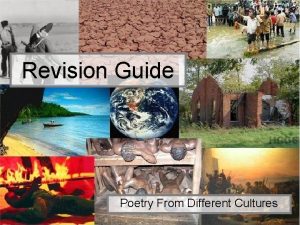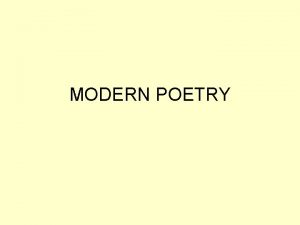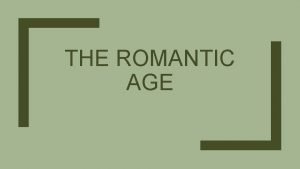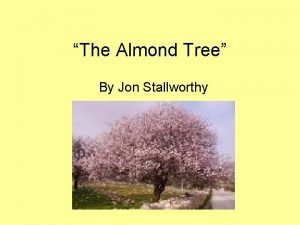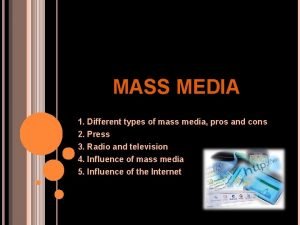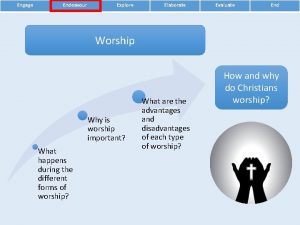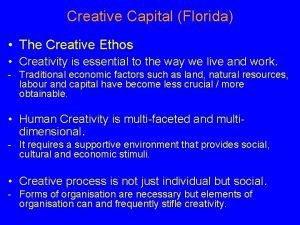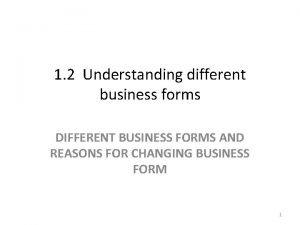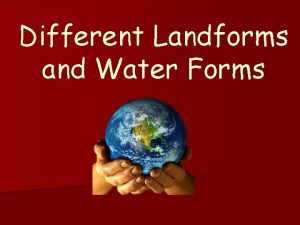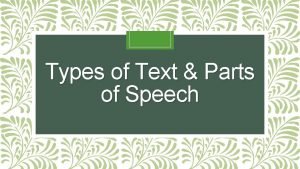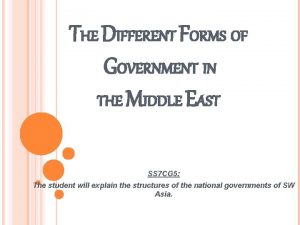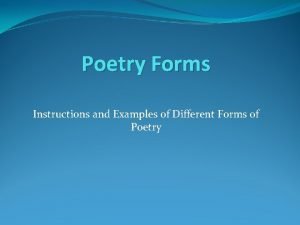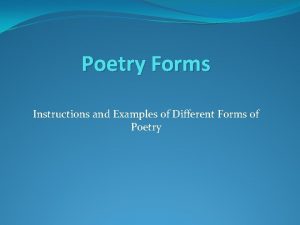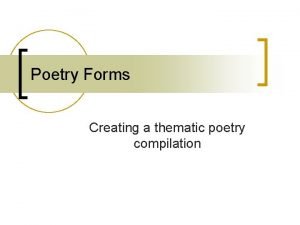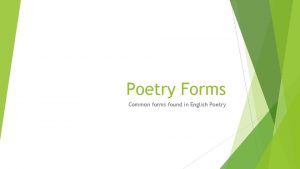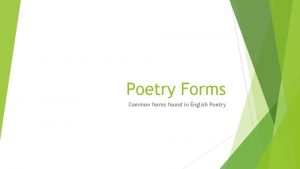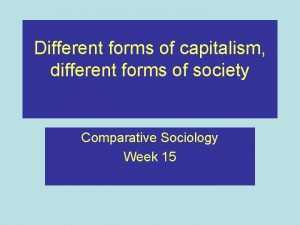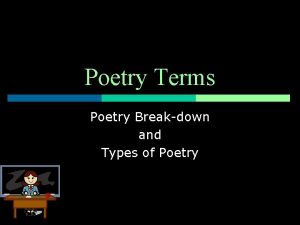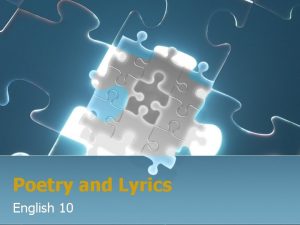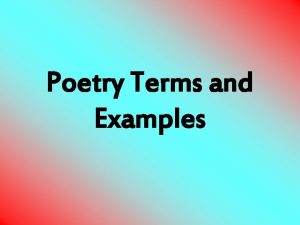Poetry Forms Instructions and Examples of Different Forms






























- Slides: 30

Poetry Forms Instructions and Examples of Different Forms of Poetry

Vocabulary for Index of Figurative Language �Alliteration �Allusion �End Rhyme �Hyperbole �Imagery �Internal Rhyme �Metaphor �Onomatopoeia �Personification �Repetition �Simile

How to Make an Index: 1. Put the terms in alphabetical order. 2. Include the page number where each figurative language example appears. 3. Write the example IN the index.

Sample (PARTIAL) Index: Alliteration, 8 “Why are we whispering? ” whispered the Max. Allusion, 3 “My backyard is a Garden of Eden. ” 7 “My hopes are sinking like the Titanic. ” End Rhyme, 2 “Must always end in gloom; It closes like a tomb!” Imagery, 9 “The grimy scraps Of withered leaves about your feet And newspapers from vacant lots. ”

My Favorite Place Imagery Poem Imagery poems are found in poems where the writing appeals to the senses. Imagery is one of the seven categories of figurative language. Imagery intensifies the impact of the poet’s words as he shows us with his words rather than just telling us what he feels.

The Swing By Robert Louis Stevenson How do you like to go up in a swing, Up in the air so blue? Oh, I do think it the pleasantest thing Ever a child can do! Up in the air and over the wall, Till I can see so wide, River and trees and cattle and all Over the countryside— Till I look down on the garden green, Down on the roof so brown— Up in the air I go flying again, Up in the air and down!

How to write a Diamonte Poem line 1 - one noun (subject #1) line 2 - two adjectives (describing subject #1) line 3 - three participles (end in-ing, tell about subject #1) line 4 - four nouns (first two relate to subject #1, second two relate to subject #2) line 5 - three participles (end in -ing, tell about subject #2) line 6 - two adjectives (describing subject #2) line 7 - one noun (subject #2)

Diamonte Poems Synonym Poem Monsters Creepy, sinister Hiding, lurking, stalking Vampires, werewolves, mummies, and zombies Chasing, Pouncing, Eating Hungry, scary Creatures

Diamonte Poems Antonym Poem Day Bright, sunny Laughing, playing, doing Up in the east, down in the west Talking, Resting, Sleeping Quiet, dark Night

Where I’m From Template I am from ______ (specific ordinary item that is important to you or that you use a lot) from _________ ( product name that is important to you - lego, Adidas, etc. ) I am from _________(sensory description of home). I am from _________ (plants, flowers, tree in your yard or home) and the ____________ (another item from nature). I am from ______________ ( a family tradition) from ___________ (family name) and_______(family name) and _______(family name) from ____________ (family trait, like being athletic, or talking a lot, or reading) from ______ (something you were told as a child) and ______(another) I am from ________ (representation of religion or belief system) I am from _______ (place of birth or ancestry) and ______ and _____ (two food items that are special to your family). from the __________ (specific often told family story) and ________ (another story about another family member )

Where I’m From (Sample) by George Ella Lyon I am from clothespins, from Chlorox and carbon-tetrachloride. I am from the dirt under the back porch. (Black, glistening, it tasted like beets. ) I am from the forsythia bush The Dutch elm whose long-gone limbs I remember. as if they were my own. I’m from fudge and eyeglasses, f. From Imogene and Alafair, I’m from the know-it-alls and the pass-it-ons, from Perk up! And Pipe down! I’m from He restoreth my soul with a cottonball lamb and ten verses I can say myself. I ‘m from Artemus and Billie’s Branch, fried corn and string coffee. From the finger my grandfather lost to the augur, and the eye my father shut to keep his sight. Under my bed was a dress box spilling old pictures, a sift of lost faces to drift beneath my dreams. I am from those moments – snapped before I budded – leaf-fall from the family tree.

Where I’m From (kid sample) I am from legos, nerf, swords, and overdue library books I am from socks on the floor and piles of books everywhere I am from the mondo grass under the treehouse and the rose bushes we moved so we would stop getting stabbed by thorns I am from summers with my cousins and spring allergies, from the Ortegas and the Pearsons, and the Hoppers and the Turgeons. I am from the procrastinators and the loud singers. From pick up your socks! And take out the trash! I am from morality and spirituality exist in the heart I’m from Atlanta and Kansas City and South Carolina and Mexico, from fish tacos and homemade chicken noodle soup. From the time my aunt got hit by a flying hotdog, about the time my brother dropped a nerf sword on my head and I had to get staples, and the time my friend threw a nerf gun at my face and I had to get stitches. I am from the framed photos on the piano that show our strong family resemblance and how much we have grown.

Concrete Poems

Concrete Poems

Personification Poems use personification throughout the entire poem to tell a story. Dinnertime Chorus by Sharon Hendricks The teapot sang as the water boiled The ice cubes cackled in their glass the teacups chattered to one another. While the chairs were passing gas The gravy gurgled merrily As the oil danced in a pan. Oh my dinnertime chorus Kiss by Earl Graham I am sending you a kiss That will land on your knee, Climb up your leg, Scramble over you back, And hide in your hair. Then, when you are about to fall asleep, It will bite you gently on your neck And whisper in your ear, ‘I love you’. What a lovely, lovely clan!

Cinquain Poem 1. Cinquains are five lines long. 2. They have 2 syllables in the first line, 4 in the second, 6 in the third, 8 in the fourth line, and just 2 in the last line. 3. Cinquains do not need to rhyme, but you can include rhymes if you want to.

Cinquain Poems Ice cream. Cold and yummy. I love its sweet richness as it finds its way into my tummy. My room is such a mess. Toys all over the place. Mom says, “Clean up!” But I like it like this.

Haiku Poems • Traditional haikus consist of THREE lines of 5, 7, and 5 syllables • Usually about nature An old silent pond. . . A frog jumps into the pond, splash! Silence again. An ocean voyage As waves break over the bow The sea welcomes me

Clerihews have just a few simple rules: 1. They are four lines long. 2. The first and second lines rhyme with each other, and the third and fourth lines rhyme with each other. 3. The first line names a person, and the second line ends with something that rhymes with the name of the person. 4. A clerihew should be funny.

Clerihews N'Sync Stink. Their music hurts my ears. I much prefer Britney Spears The enemy of Harry Potter Was a scheming plotter. I can't tell you what he's called; I'd be ashamed To name "he who must not be named. "

Limericks are short, funny poems that follow a particular pattern. Five lines with an A A B B A rhyme scheme The meter is rhythmic with the first, second, and fifth lines having three feet (simplest definition: beats or stressed syllables) and the third and fourth lines having 2 feet. One of the most famous and prolific authors of limericks is Edward Lear.

Limericks by Edward Lear � There was an Old Man with a beard, Who said, 'It is just as I feared! Two Owls and a Hen, Four Larks and a Wren, Have all built their nests in my beard!‘ � There was a Young Lady whose eyes, Were unique as to colour and size; When she opened them wide, People all turned aside, And started away in surprise.

Villanelles The villanelle is a highly structured poem consisting of nineteen lines. Five tercets (stanzas of three lines) followed by a quatrain (stanza of four lines) The first and third line of the opening tercet are repeated alternately as the last lines in the following stanzas. These two lines also serve as the last two lines in the poem. The rhyme scheme is ABA ABA ABAA One of the most famous villanelles is Dylan Thomas’s “Do No Go Gentle into that Good Night”

Example of a Villanelle “Do Not Go Gentle into that Good Night” by Dylan Thomas Do not go gentle into that good night, Old age should burn and rave at close of day; Rage, rage against the dying of the light. A B A Though wise men at their end know dark is right, Because their words had forked no lightning they Do not go gentle into that good night. A B A Good men, the last wave by, crying how bright Their frail deeds might have danced in a green bay, Rage, rage against the dying of the light. A B A Wild men who caught and sang the sun in flight, And learn, too late, they grieved it on its way, Do not go gentle into that good night. A B A Grave men, near death, who see with blinding sight Blind eyes could blaze like meteors and be gay, Rage, rage against the dying of the light. A B A And you, my father, there on the sad height, Curse, bless, me now with your fierce tears, I pray. Do not go gentle into that good night. Rage, rage against the dying of the light. A B A A

Sonnets There are many different types of sonnets. The simplest may be the English style. It includes the following characteristics: They usually examine two contrastive elements Fourteen lines Each line has 10 syllables The rhyme scheme is A B CDCD EFEF GG The couplet at the end is frequently a twist or surprise.

Sonnets: Shakespeare’s 18 th Shall I compare thee to a summer's day? Thou art more lovely and more temperate. Rough winds do shake the darling buds of May, And summer's lease hath all too short a date. Sometime too hot the eye of heaven shines, And often is his gold complexion dimmed; And every fair from fair sometime declines, By chance, or nature's changing course, untrimmed; But thy eternal summer shall not fade, Nor lose possession of that fair thou ow'st, Nor shall death brag thou wand'rest in his shade, When in eternal lines to Time thou grow'st. So long as men can breathe, or eyes can see, So long lives this, and this gives life to thee. A B C D E F G G

Sonnets: “Learning to Write a Sonnet” by Denise Rogers The sonnet form is old and full of dust And yet I want to learn to write one well. To learn new forms and grow is quite a must, But I will learn it quickly, I can tell. A B And so I sit, today, with pen in hand, Composing three new quatrains with a rhyme. The rhythm flows like wind at my command. The A-B-A-B form consumes my time. C D But I’m not done until there’s fourteen lines. One ending couplet, after three quatrains. I’ve tried to write this new form several times. The effort’s huge; I have to rack my brain. E F But I persist, my fourteen lines now done. I wrote my poem; my sonnet work is won. G G

Extended Metaphor The entire poem is a metaphor comparing one thing to another. Examples: Hope is the Thing with Feathers The entire poem is comparing Hope to a bird singing through a storm. Mother to Son by Langston Hughes The entire poem is comparing life’s journey to walking up a flight of stairs

Examples “Hope” is the thing with feathers – That perches in the soul And sings the tune without the words And never stops - at all And sweetest - in the Gale - is heard And sore must be the storm That could abash the little Bird That kept so many warm I’ve heard it in the chillest land And on the strangest Sea Yet - never - in Extremity, It asked a crumb - of me. - Emily Dickinson Mother to Son Well, son, I’ll tell you: Life for me ain’t been no crystal stair. It’s had tacks in it, And splinters, And boards torn up, And places with no carpet on the floor— Bare. But all the time I’se been a-climbin’ on, And reachin’ landin’s, - Langston Hughes And turnin’ corners, And sometimes goin’ in the dark Where there ain’t been no light. So boy, don’t you turn back. Don’t you set down on the steps ’Cause you finds it’s kinder hard. Don’t you fall now— For I’se still goin’, honey, I’se still climbin’, And life for me ain’t been no crystal stair.

 Types of lyric poetry
Types of lyric poetry Market form of meat which is preserved by chemical process
Market form of meat which is preserved by chemical process Lyric poetry ode examples
Lyric poetry ode examples Why do different polymers have different properties
Why do different polymers have different properties Why do different atoms produce different colors
Why do different atoms produce different colors Sound will travel at different speeds in different mediums.
Sound will travel at different speeds in different mediums. Library thinkquest org 19537
Library thinkquest org 19537 Cultural relarivism
Cultural relarivism Different angle different story
Different angle different story Different faces song
Different faces song Different materials have different
Different materials have different Different people different things
Different people different things Argumenterande tal struktur
Argumenterande tal struktur Why nobody pets the lion at the zoo
Why nobody pets the lion at the zoo Spoken poetry about cultural relativism
Spoken poetry about cultural relativism Poetry character cavalier
Poetry character cavalier Experimentation in modern poetry
Experimentation in modern poetry Augustan age characteristics
Augustan age characteristics Jon stallworthy the almond tree
Jon stallworthy the almond tree Negative contracted form
Negative contracted form Weak and strong forms
Weak and strong forms What are vitamins functions
What are vitamins functions 3 types of mass media
3 types of mass media Different forms of linear equations
Different forms of linear equations Mussels market form
Mussels market form Types of prayers
Types of prayers Creative ethos
Creative ethos Different business forms
Different business forms Kind of water forms
Kind of water forms Different forms of text
Different forms of text Different forms of government
Different forms of government


